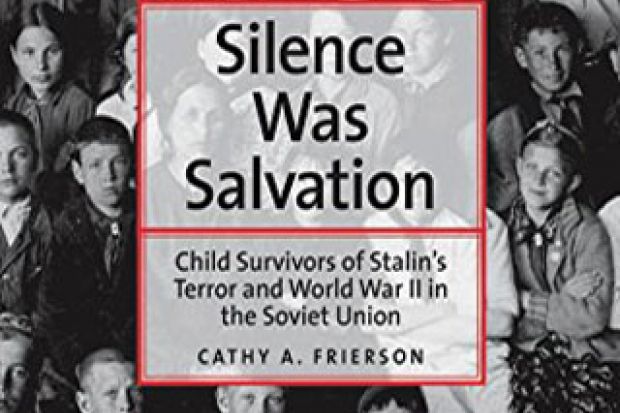Maya Rudolfovna clearly remembers the last time that she saw her father. Then nine years old, she was in bed with tonsillitis, and her father, in an attempt to distract her from feeling ill, was holding a globe in his hands and pointing out different countries and rivers. A ring at the door shattered this domestic scene. Her father was arrested and never seen again. This was Stalinist Russia in 1937.
Ten million children like Maya were orphaned in a similar way in the 1930s and 1940s, when one or both parents were imprisoned, exiled or executed on the orders of the Soviet government. Tainted by association, these children were branded “enemies of the people” and suffered economic, political and social penalties as a result. It is hardly a secret that there was widespread terror under Stalin’s rule, but the ramifications in the private sphere are often overlooked. Silence of Salvation addresses this, sharing the interviews that Cathy Frierson conducted with 10 survivors of childhood trauma during the Soviet era. Each interviewee recounts shocking experiences in vivid detail, thereby not only enhancing our sense of life in the Soviet Union but also helping us to see the countless victims of the Soviet terror in three dimensions rather than as abstract figures.
Frierson’s research offers important insights into the hole left in families’ lives when one member was suddenly taken away. Although many children were told that their parents had gone away on business trips, it soon became clear that this was not the case. Families were forced to live with the uncertainty about the whereabouts of their relatives, often for years on end. Some children later recalled the care with which they prepared parcels to send to their imprisoned parents; others remembered long and difficult journeys to the prisons, where they were sometimes permitted to spend a few hours with their mother or father.
There were serious consequences for child survivors of the terror outside the home, too. At worst they were treated as outcasts, bullied at school and barred from studying their favoured subjects at university, all because their parents were “traitors to the motherland”. Alongside these deeply negative experiences, however, Silence Was Salvation also reveals the key role of the many teachers and nannies who acted as good Samaritans in helping these children to survive and prosper despite the trying circumstances.
Perhaps unsurprisingly, many of the interviewees remember Stalin’s death in March 1953 as something of a relief. They had grown used to hearing screaming in the night as neighbours were hauled off at the government’s behest, but such occurrences seemingly ceased overnight, and people could sleep more easily in their beds. But although these survivors generally shared similar views about Stalin, their attitudes to communism were much less straightforward. After all, they had been socialised in the society they were victims of. So despite the serious damage Stalin’s reign had caused to their home lives, their whole outlook was informed by the prevailing attitudes of the time and so they adopted many collaborative, community-oriented values.
Although this collection would have been enhanced by a concluding section drawing together the disparate strands of the 10 testimonies, Frierson’s work is invaluable in adding another piece to the puzzle of what everyday life was like under Stalin.
Silence Was Salvation: Child Survivors of Stalin’s Terror and World War II in the Soviet Union
By Cathy A. Frierson
Yale University Press, 288pp, £16.99
ISBN 9780300179453
Published 16 March 2015
Register to continue
Why register?
- Registration is free and only takes a moment
- Once registered, you can read 3 articles a month
- Sign up for our newsletter
Subscribe
Or subscribe for unlimited access to:
- Unlimited access to news, views, insights & reviews
- Digital editions
- Digital access to THE’s university and college rankings analysis
Already registered or a current subscriber? Login





